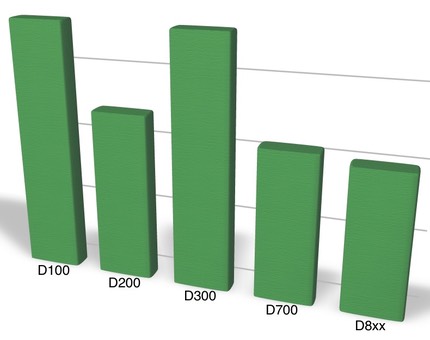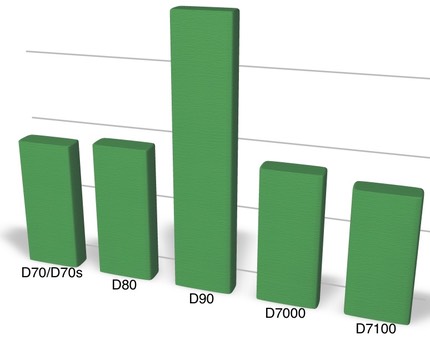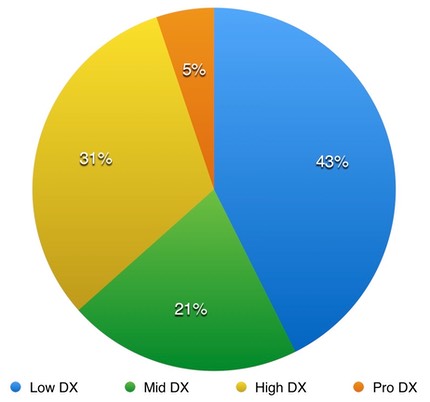This is the fourth in my series of analysis of a set of numbers for Nikon DSLR sales (previously: overall volume, DX vs FX, Nikon’s own numbers). This time around, I’m going to tackle the “prosumer" models, starting with the ones with the three digits after the D.

worldwide unit volume, camera lifetime
Was the D300 a seminal camera? Yes. (This chart includes D300 and D300s together, by the way, and it also graphs the D800, D800E, and D810 together.)
That’s despite the fact that the D300 came out at the same time as Nikon’s foray into FX, and all the things that implies.
The cameras charted above have ranged from about US$1800 to US$3200 in list price at their introduction. That’s a pretty hefty price tag, far above average selling price of cameras. But they’re all professional build quality and design, and they’ve all been groundbreakers at their introduction.
The “discounted” version of the D300/D300s was the D90 (basically the D70 thru D7200 represent the top consumer design models that parallel just beneath the cameras just graphed). So perhaps it might be interesting to see how that line fared:

worldwide unit volume, camera lifetime
I left off the D7200 because it’s relatively new and still selling, thus its current numbers thus don’t look right compared to the ones charted above.
To refresh your memory of when all these models I’ve mentioned so far came out:
2004 = D70
2006 = D80
2007 = D300
2008 = D90 / D700
2010 = D7000
2012 = D800/D800E
2013 = D7100
2014 = D810
Peak DSLRs were 2011/2012/2013 depending upon how you call the peak.
Remember, the D90 was the “low cost” D300, but with the same sensor. What do you bet that the D7300 repeats this same scenario if the D500 proves to be insanely popular? (I’ll give it 3:2 odds.)
Okay, now for the chart that’s going to really rattle the discussion. What has been the mix of DX models overall? I’m going to break DX into four categories: low DX (e.g. D3xxx), mid DX (e.g. D5xxx), high DX (e.g. D7xxx), and pro DX (e.g. D300). (I had to put the D60 somewhere, so I put it in low DX, even though some could argue it should go in mid DX.)
I’m going to chart the mix of those models' unit volume from 2007 to the present. I should also note that the sell through on a lot of these DX models is still in progress, especially at the low end. I’m comfortable with the numbers for the upper categories, but I’m not at all 100% confident about the numbers for the lower categories, for the reason just given plus the fact that I seem to be missing some data from one region’s sales in the data set I’m using:

Worldwide unit volume, 2007-2015
Shocked?
One argument that has been used against my contention that we need a full DX lens set (buzz buzz) is that so many of the DX sales had to be low end models that will only ever get a kit lens on them. Yet 36% of the DX sales I can chart during the 2007-2015 period are D7xxx and up. Even if I were missing 50% of the lower end DX sales in my figures—which I’m pretty sure I’m not—the high end still suggests very high sales numbers, high enough to warrant a fuller lens set. Indeed, even though I knew that intuitively from my long history of following everything Nikon, I was a little surprised at just how high the unit volume in the D7xxx and up category was for DX.
(Some may be shocked that the middle model is lower than the low and high models in the consumer DX line. I’m not. One reason for a middle model to exist is to upsell the low end customers—that’s why the D5xxx has a swivel screen, by the way—and to still make a sale to those that decide the high end just costs too much. Mid models are like vacuums trying to suck extra dollars or extra customers that wouldn’t be gotten from having only two models in the line.)





